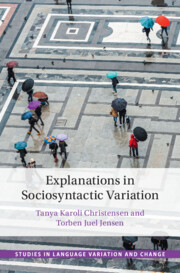Book contents
- Explanations in Sociosyntactic Variation
- Studies in Language Variation and Change
- Explanations in Sociosyntactic Variation
- Copyright page
- Contents
- Figures
- Tables
- Contributors
- Series Editor’s Preface
- Acknowledgements
- Introduction: Analysing and Explaining Syntactic Variation
- 1 Comparing Syntactic Variables
- 2 Mapping Syntax and the Sociolinguistic Monitor
- 3 A Columbia School Perspective on Explanation in Morphosyntactic Variation
- 4 On the Inevitability of Social Meaning and Ideology in Accounts of Syntactic Change: Evidence from Pronoun Competition in Netherlandic Dutch
- 5 The Predictability of Social Stratification of Syntactic Variants
- 6 When Variants Lack Semantic Equivalence: Adverbial Subclause Word Order
- Index
- References
2 - Mapping Syntax and the Sociolinguistic Monitor
Published online by Cambridge University Press: 06 January 2022
- Explanations in Sociosyntactic Variation
- Studies in Language Variation and Change
- Explanations in Sociosyntactic Variation
- Copyright page
- Contents
- Figures
- Tables
- Contributors
- Series Editor’s Preface
- Acknowledgements
- Introduction: Analysing and Explaining Syntactic Variation
- 1 Comparing Syntactic Variables
- 2 Mapping Syntax and the Sociolinguistic Monitor
- 3 A Columbia School Perspective on Explanation in Morphosyntactic Variation
- 4 On the Inevitability of Social Meaning and Ideology in Accounts of Syntactic Change: Evidence from Pronoun Competition in Netherlandic Dutch
- 5 The Predictability of Social Stratification of Syntactic Variants
- 6 When Variants Lack Semantic Equivalence: Adverbial Subclause Word Order
- Index
- References
Summary
Sociolinguistic research demonstrates that speakers are ‘aware’ of some variables in their speech patterns, but not others, as evidenced by, for example, style shifting. In explaining this bifurcation, Labov (1993, 2008) suggests that speakers have a sociolinguistic monitor where ‘members of the speech community evaluate the surface forms of language but not more abstract structural features’. However, determining which linguistic variables are ‘surface’ and which are more ‘abstract’ is far from clear. In this chapter we test the sociolinguistic monitor by comparing the use of two variables which are considered to be abstract structural features - negative concord and use of never for didn't. We compare the use of these forms across two datasets: one where community members are in conversation with a community insider and another with a community outsider. We find that there is style shifting according to interlocutor with negative concord but not with never for didn’t, suggesting that only the former is ‘monitored’ in the speech of this community. These findings suggest that social pressures override similarities across linguistic structure in the operation of the sociolinguistic monitor.
- Type
- Chapter
- Information
- Explanations in Sociosyntactic Variation , pp. 58 - 89Publisher: Cambridge University PressPrint publication year: 2022



